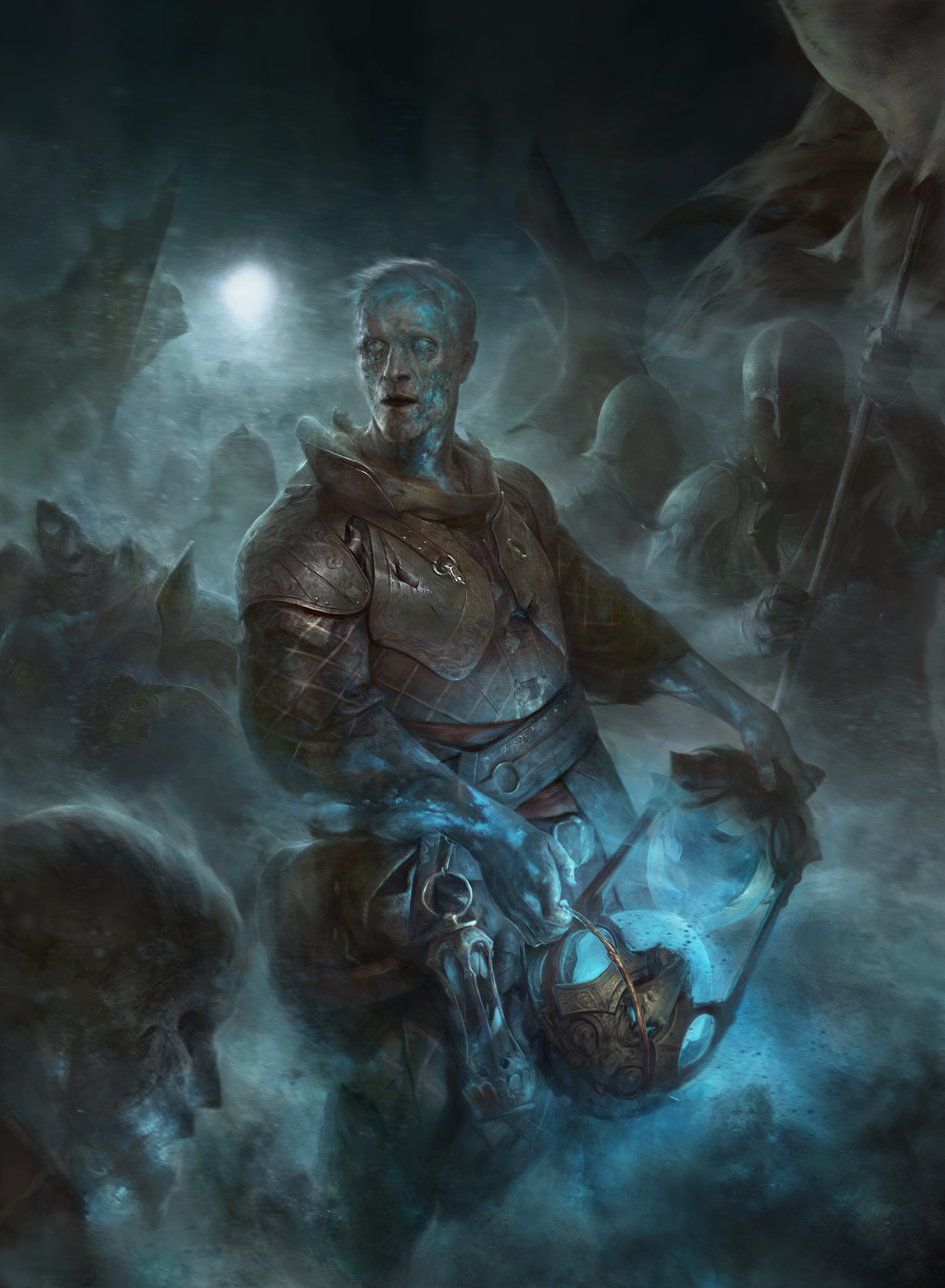
Compendium
of the
Dark Arts
The secrets of the world's most powerful liches and undead lay before you. Whether you are looking to fill your lich's lair with fearsome guards, awarding undead treasure, or seeking more necromancy spells, the Necronomicon has it all. This is an ongoing collection and will receive updates in the future.
Cover Art: Stepan Alekseev
Table of Contents

Introduction
This tome is the collection of thousands of years of secrets and unspeakable horrors of the dark arts. It contains manuscripts of rituals, spells, and undead monsters that no entity less unholy than a lich may comprehend. Should any living creature dare to even graze its pages, they'll find their soul wither away.
Art by Ihor Reshetnikov
The Necronomicon
Wondrous Item, legendary
This book contains secrets of necromancy, which are written in Abyssal. All existing copies of this book are linked by a strange, terrible magic. It keeps the contents of all copies identical and prevents extra copies from being procured anything less powerful than a lich.
Any non-undead creature that touches or attempts to read this book becomes cursed, suffering the following effects. None of these can be removed until the curse itself is removed.
- It can't benefit from a long rest, and its hit points can't be restored.
- Its Channel Divinity features have a 50% chance to fail outright when used.
- It suffers a random effect from the Long-Term Madness table on page 260 in the Dungeon Master's Guide.
- After dying, its corpse remains cursed. It's immune to the gentle respose spell and its soul cannot reconvene with it. Thus, it cannot be resurrected with anything short of a true resurrection or wish spell, either of which will end the curse.
The curse can be removed with magic, such as a remove curse (level 3) spell, but the caster must succeed a DC 20 Wisdom (Religion) ability check unless they use a 9th level spell. If unsuccessful, the curse will have no chance of being removed without a 9th level spell for the next 24 hours or if conditions improve. The check has advantage if the cursed creature is affected by a divine effect, such as the protection against good and evil spell, or is in an area of holy power, such as by the hallow spell.

Becoming a Lich
Any wizard of 17th level or higher can become a lich by casting this spell. Your DM can simply add this wizard spell to your adventure, perhaps printed on an ancient spell scroll or in an acolyte's tome. Like many works of necromancy, it's likely this spell is written in Abyssal.
Rite of Lichdom
9th-level necromancy (ritual)
- Casting Time: 7 days
- Range: Self
- Components: V, S, M (gemstones worth 8000 gp and a mixture of rare bloods and poisons worth 8000gp, which you must consume)
- Duration: Instantaneous
- Classes: Wizard
As part of the casting of this spell, you create a phylactery out of the gemstones and brew the rare bloods and poisons into a lethal potion. As part of the casting of this spell, you create a phylactery out of the gemstones and brew the rare bloods and poisons into a lethal potion.
To complete the spell, you must drink the potion and die by it, after which you will raise as undead. The undead tag is added to your original nature, and you are treated as undead for the purpose of spells and effects. After reviving, you become a lich, and your soul is stored in your phylactery, ready to be stowed away.
If you die as a lich, you will resurrect after 1d10 days, appearing in the unoccupied space closest to your phylactery. If your phylactery is destroyed while you are still alive, you can spend a week and gems worth 8000 gp to create another. If you are ever dead while your phylactery is destroyed, you can't be revived without a wish spell. If your phylactery is ever in danger, you will know of it through divination magic.
As a lich, you gain the following benefits
- You don't need to breath, eat, sleep, or drink, though you still can. You also automatically succeed on Constitution saving throws against extreme cold and heat between -50 and 140 degrees Fahrenheit.
- While you have 0 hit points and are dying, you are vulnerable to radiant damage and are stunned instead of unconscious.
- You can read, write, speak, and understand Abyssal.
- While you are not wearing armor or a shield, your base AC becomes 14 + your Dexterity modifier.
- You are resistant to cold, lightning, and necrotic damage .
- You are immune to poison damage, as well as bludgeoning, piercing, and slashing damage from nonmagical attacks.
- You have advantage on saving throws against any effect that turns undead.
- You can't be charmed, exhausted, frightened, paralyzed, or poisoned.
- You gain truesight with a range of 120 feet.
- You gain Legendary Resistance; if you fail a saving throw, you can choose to succeed instead. You can do this three times. You regain all uses after you complete a long rest.
- With unlimited range, you can cast the clairvoyance spell on your phylactery as an action without material components or spending a spell slot.
- All necromancy wizard spells are added to your spellbook, and they don't count against your list of prepared spells. For each necromancy spell already in your spellbook, you can add a spell from any other school instead.
Additionally, You can use your action to perform one of the following abilities.
Frightening Gaze. You focus your gaze into a creature you can see within 30 feet. The target must succeed a Wisdom saving throw or be affected as though by the fear spell. After an creature successfully saves or this effect ends for it, it cannot be affected by this for 24 hours.
Paralyzing Touch. You make a melee spell attack against a creature you can see within 5 feet of you. On hit, the target takes 2d6 cold damage. The target must succeed on a Constitution saving throw or be paralyzed for 1 minute. The target can repeat the saving throw at the end of each of its turns, ending the effect on itself on a success.
Art by Cristi Balanescu
PART 1
Undead Familiars
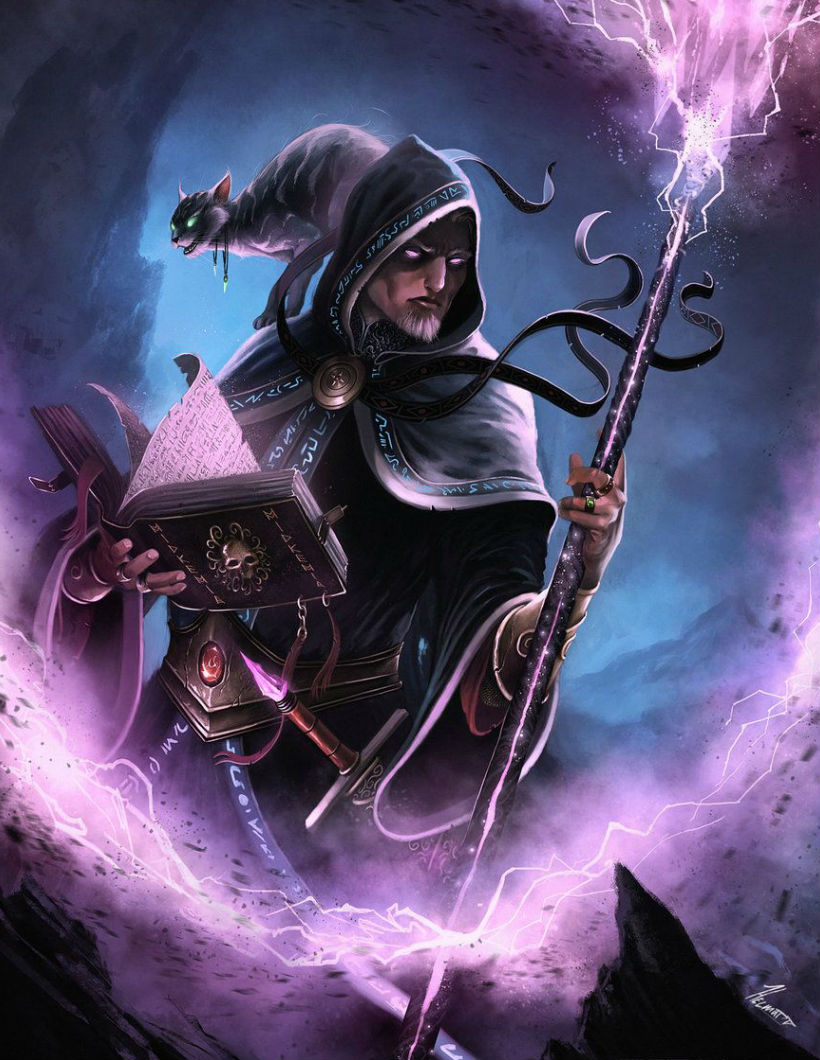
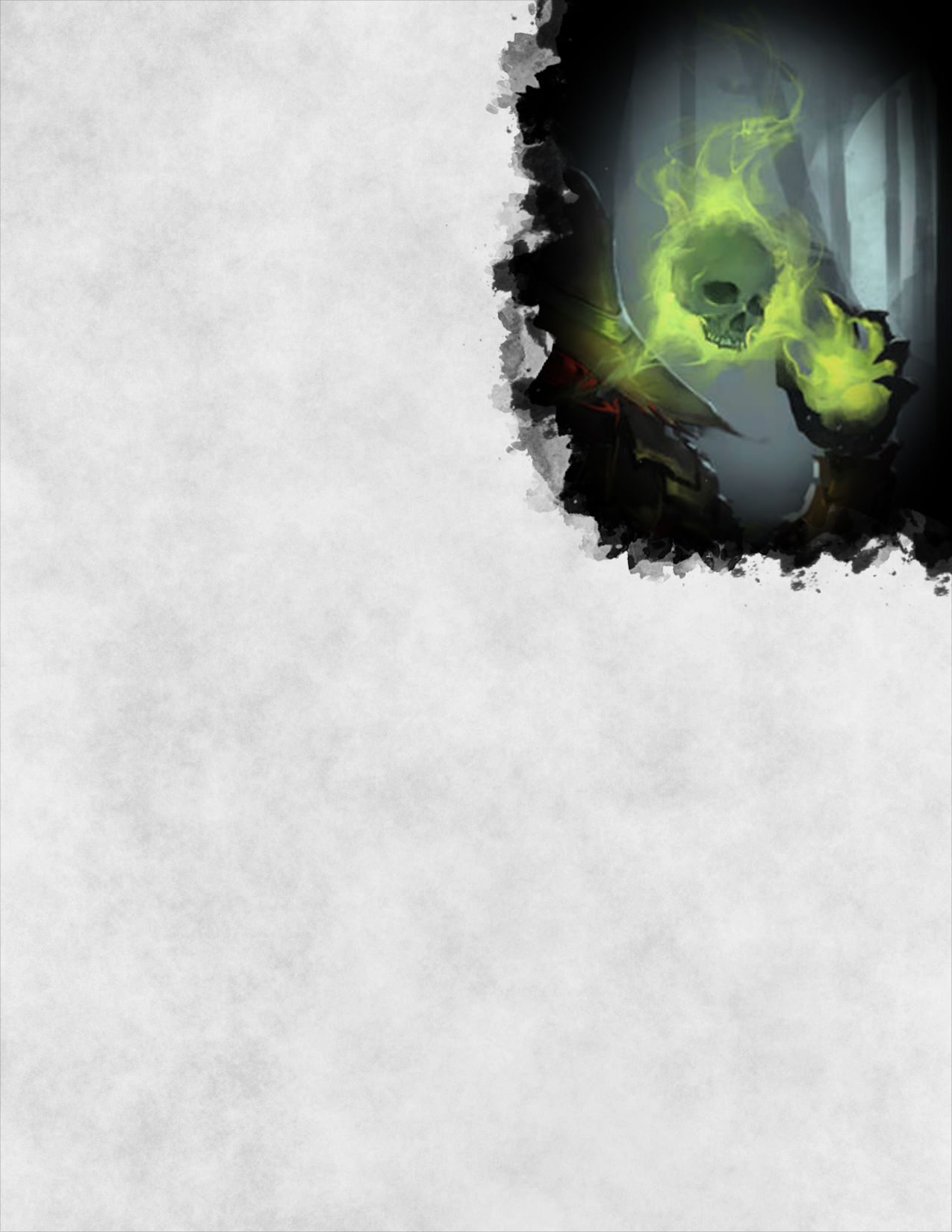
Undead Familiars
By default, only Necromancer Liches can use these monsters as undead familiars with their Adept Necromancy feature. However if the DM allows, you may appropriate undead familiars into your character as you wish.
If your familiar takes the form of a creature with the Undead Familiar trait, it nature becomes undead. Like normal living familiars, these creatures exist out in the world as detailed in their stat block. As your familiar however, their alignment, languages known, or behavior may change to better suit your character.
Flying Skull
Created from the remains of dead wizards, flying skulls and flameskulls are commonly found perusing a lich's lair or the grounds of a necromancer cult. Though usually green, their flames can actually shine in any color. Like flameskulls, flying skulls keep themselves afloat by sheer anger alone.
Pyromaniacs. Flying skulls know only fire-related spells. In the dark, they'll provide a much needed source of light and can circumvent resistance against non-magical weapon attacks.
Flying Skull
Tiny undead, chaotic evil
- Armor Class 13
- Hit Points 18 (4d6+4)
- Speed 0 ft., fly 40 ft. (hover)
STR DEX CON INT WIS CHA 2 (-4) 15 (+2) 13 (+1) 16 (+3) 13 (+1) 12 (+1)
- Skills Perception +4
- Damage Resistances fire, necrotic, piercing
- Damage Immunities poison
- Condition Immunities charmed, frightened, paralyzed, poisoned, prone
- Senses darkvision 60 ft., passive Perception 14
- Languages Common and Abyssal
- Challenge 1/4
Undead Familiar. A familiar in this creature's form assumes the nature of undead.
As a familiar, it can still ignite flammable objects with fire bolt, but without dealing damage.
Illumination. With the fire within itself, the flying skull sheds either dim light in a 15-foot radius, or bright light in a 15-foot radius and dim light for an additional 15 feet. It can switch between the options or disable it as an action.
Rejuvenation. If the flying skull is destroyed, it regains all its hit points in 1 hour unless holy water is sprinkled on its remains or a dispel magic or remove curse spell is cast on them.
Spellcasting. The flying skull's innate spellcasting ability is Charisma (spell save DC 12). It can innately cast the following spells, requiring no material components:
- Cantrip (at will): mage hand, control flames, fire bolt
Actions
Fire Bolt. Ranged Spell Attack: +4 to hit, range 120ft., one target. Hit: 6 (1d10) fire damage. A flammable object hit by this spell ignites if it isn’t being worn or carried.
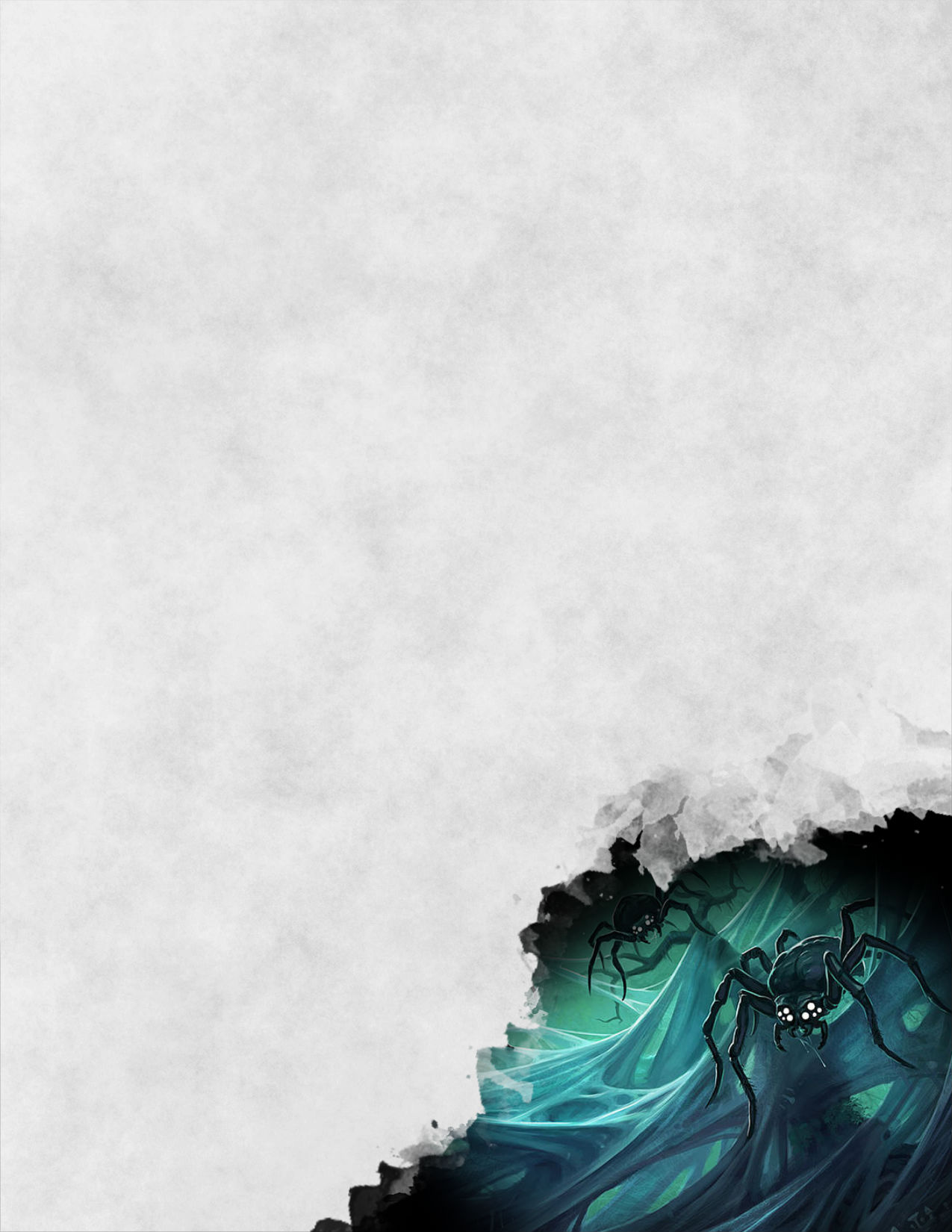
Creeping Claw
Left to its own devices long enough, a crawling claw can learn to leap, becoming a creeping claw. Thus, they are known to get into surprisingly difficult places and for being a nuisance in general.
Creeping Claw
Tiny undead, chaotic evil
- Armor Class 13
- Hit Points 18 (5d4+5)
- Speed 20 ft., climb 20 ft.
STR DEX CON INT WIS CHA 12 (+1) 16 (+3) 13 (+1) 6 (-2) 10 (0) 4 (-3)
- Damage Immunities poison
- Condition Immunities charmed, exhaustion, frightened, poisoned
- Skills Athletics +4, Stealth +6
- Senses blindsight 30 ft. (blind beyond this radius), passive Perception 10
- Languages understands Common and Abyssal but cannot speak
- Challenge 1/4
Undead Familiar. A familiar in this creature's form assumes the nature of undead. As a familiar, it can still use the grab action.
Leaping. At the cost of 10 feet of its movement, the claw can jump up to 10 feet without needing to make an ability check.
Tight Grab. If a medium-sized creature grappled by the claw has a limb, the claw will seize one, imposing disadvantage on attack rolls until released. The claw can't drag its grappled target, and the target can still move freely. While attached to the target, the claw travels with it should it move or teleport, maintaining the grapple.
Actions
Claw. Melee Weapon Attack: +3 to hit, reach 5 ft., one creature. Hit: 4 (1d6) bludgeoning or slashing damage (claw's choice).
Grab. Melee Weapon Attack: +3 to hit, reach 5 ft., one creature. On hit, the target is grappled. This attack has disadvantage if the target is medium-sized, unless it has limb to latch on to, or if the target is huge-sized or larger. The claw may jump as part of this attack.
Hollow Spider
This larger-than-normal spider is empty on the inside... literally. It is hollow as it is sneaky and creepy. Hollow spiders tend to be found deep in catacombs where no living insects can survive.
Hollow Spider
Tiny undead beast, unaligned
- Armor Class 13
- Hit Points 23 (5d6+5)
- Speed 25 ft., climb 25 ft.
STR DEX CON INT WIS CHA 7 (-2) 16 (+3) 13 (+1) 6 (-2) 13 (+1) 12 (+1)
- Skills Stealth +6
- Damage Immunities poison
- Condition Immunities exhaustion, frightened, poisoned
- Senses blindsight 5 ft., darkvision 60 ft., passive Perception 11
- Challenge 1/4
Undead Familiar. A familiar in this creature's form assumes the nature of undead.
Spider Climb. The spider can climb difficult surfaces, including upside down on ceilings, without needing to make an ability check.
Web Sense. While in contact with a web, the spider knows the exact location of any other creature in contact with the same web.
Web Walker. The spider ignores movement restrictions caused by webbing.
Actions
Bite. Melee Weapon Attack: +4 to hit, reach 5 ft., one creature. Hit: 4 (1d6) Piercing damage plus 4 (1d6) Poison damage.
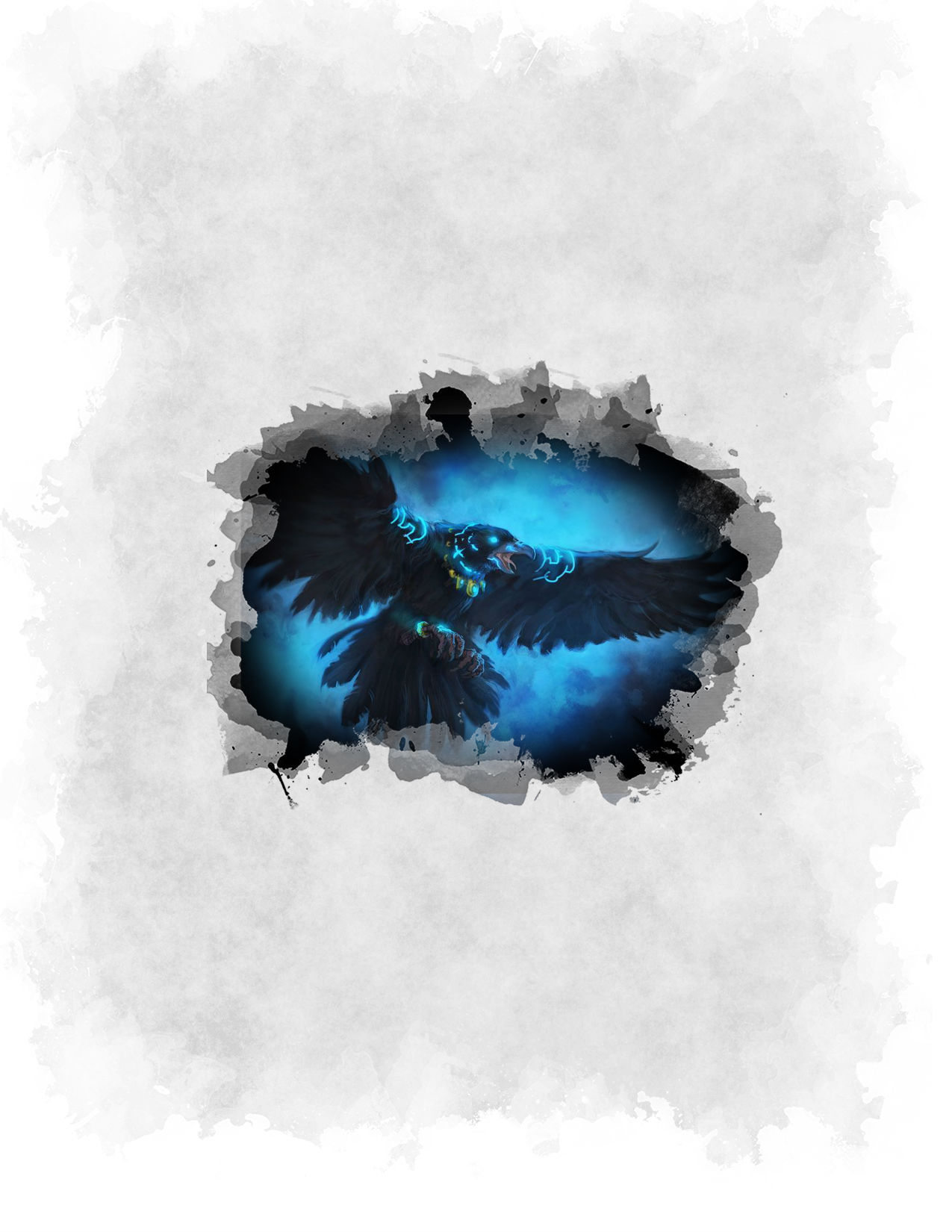
Skeletal Mage
A mage-turned skeleton... or perhaps a skeleton-turned mage?
As a familiar, it is rather intelligent compared to most others. The skeletal mage will use its message and mending cantrips tactfully, without needing your command or approval.
Skeletal Mage
Small undead, neutral evil
- Armor Class 13
- Hit Points 18 (5d6)
- Speed 25 ft.
STR DEX CON INT WIS CHA 8 (-1) 12 (+1) 11 (+0) 12 (+1) 13 (+1) 16 (+3)
- Skills Arcana +3
- Damage Immunities poison
- Condition Immunities exhaustion, poisoned
- Senses darkvision 120 Ft, passive Perception 11
- Languages those known in life
- Challenge 1/4
Undead Familiar. A familiar in this creature's form assumes the nature of undead.
Spellcasting. The skeletal mage's innate spellcasting ability is Intelligence (spell save DC 12). It can innately cast the following spells, requiring no material components:
- Cantrip (at will): eldritch blast, message, mending
Actions
Claw. Melee Weapon Attack: +3 to hit, reach 5 ft., one creature. Hit: 3 (1d4) slashing damage.
Eldritch Blast. Ranged Spell Attack: +4 to hit, range 120 ft., one creature. Hit: 6 (1d10) force damage.
Spectral Raven
Whether you are in the Material or Ethereal Plane, a spectral raven will find a way to perch on your shoulder. Its keen senses work in both planes, making them well suited to keep watch and scout. Without Mimicry, this stat block may still apply should you choose a different spectral bird of prey.
Spectral Raven
Tiny undead, unaligned
- Armor Class 13
- Hit Points 13 (5d4)
- Speed 10 ft., fly 50 ft.
STR DEX CON INT WIS CHA 3 (-4) 14 (+2) 10 (+0) 4 (-3) 14 (+2) 7 (-2)
- Damage Immunities poison
- Condition Immunities charmed, exhaustion, frightened, poisoned
- Skills Perception +5
- Senses darkvision 120 ft., passive Perception 15
- Languages -
- Challenge 1/4
Undead Familiar. A familiar in this creature's form assumes the nature of undead.
Ethereal Sight. The raven can see 60 ft. into the Ethereal Plane when it is on the Material Plane, and vice versa.
Flyby. The raven doesn't provoke opportunity attacks when it flies out of an enemy's reach.
Mimicry. The raven can mimic simple sounds it ha s heard, such as a person whispering, a baby crying, or an animal chittering. A creature that hears the sounds can tell they are imitations with a successful DC 10 Wisdom (Insight) check.
Keen Hearing and Sight. The raven has advantage on Wisdom (Perception) checks that rely on hearing or sight.
Actions
Talons. Melee Weapon Attack: +3 to hit, reach 5 ft., one creature. Hit: 4 (1d6) piercing damage.
Ethereal Shift. The raven enters the Ethereal Plane from the Material Plane, or vice versa. It can't affect, be affected, or be seen by anything on the other plane.
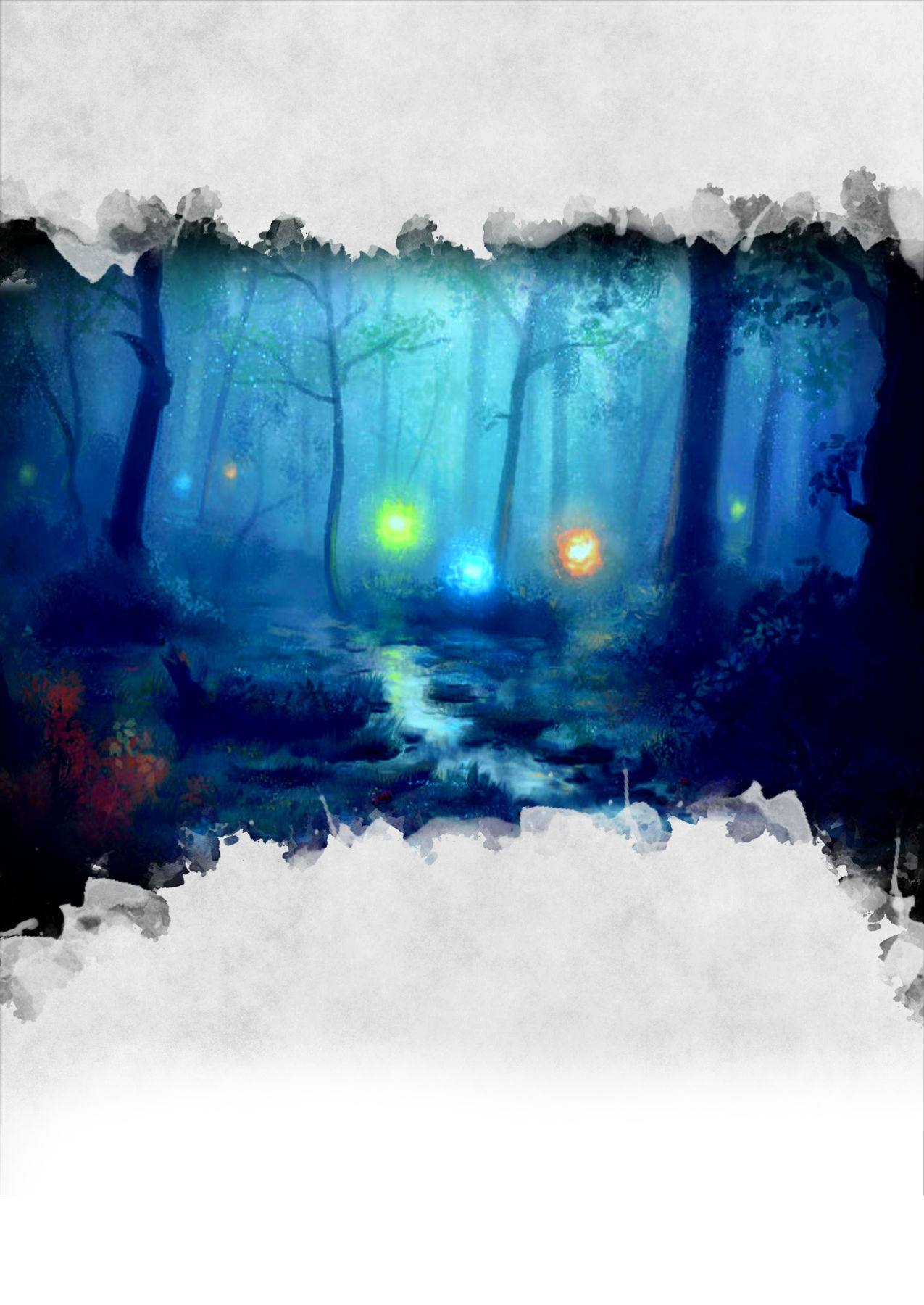
Wisp
Unlike will-o'-wisps, regular wisps are simply souls of those who've perished too early and are not inherently evil. When it dies, it heals nearby creatures before reverting back into a normal soul. It is then free to linger or rest in peace.
Wisp
Tiny undead, any alignment
- Armor Class 13
- Hit Points 13 (5d4)
- Speed 0 ft., fly 40 ft. (hover)
STR DEX CON INT WIS CHA 1 (-5) 18 (+4) 10 (+0) 13 (+1) 15 (+2) 14 (+2)
- Damage Resistances acid, cold, fire, necrotic, thunder; Bludgeoning, piercing, and slashing from nonmagical attacks
- Damage Immunities lightning, poison
- Condition Immunities exhaustion, grappled, paralyzed, poisoned, prone, restrained, unconscious
- Senses darkvision 120 Ft, passive Perception 12
- Languages those known in life
- Challenge 1/4
Undead Familiar. A familiar in this creature's form assumes the nature of undead.
Clemency. When the wisp dies, it reverts into a normal soul and all non-construct creatures within 20 feet restore 2d6 hit points.
Ephemeral. The wisp can’t wear or carry anything.
Incorporeal Movement. The wisp can move through other creatures and objects as if they were difficult terrain. It takes 5 (1d10) force damage if it ends its turn inside an object.
Variable Illumination. The wisp sheds bright light in a 5- to 20-foot radius and dim light for an additional number of feet equal to the chosen radius. The wisp can alter the radius as a bonus action.
Actions
Shock. Melee Spell Attack: +3 to hit, reach 5 ft., one creature. Hit: 4 (1d6) lightning damage.
Invisibility. The wisp and its light magically become invisible until it attacks or uses its Effuse, or until its concentration ends (as if concentrating on a spell).
Effuse. The wisp dies, reducing its own hit points to 0.
PART 2
Common and Uncommon
Monsters
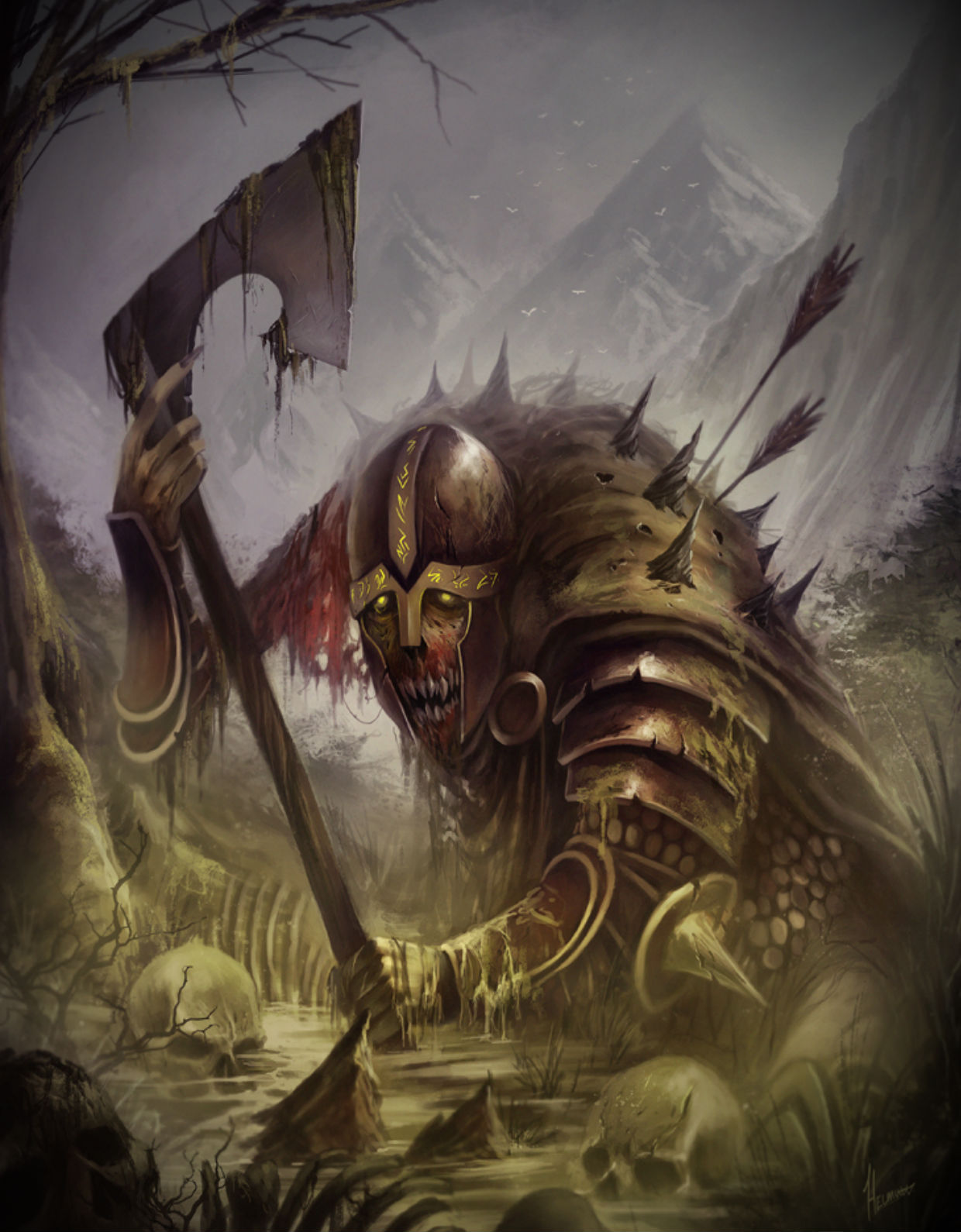
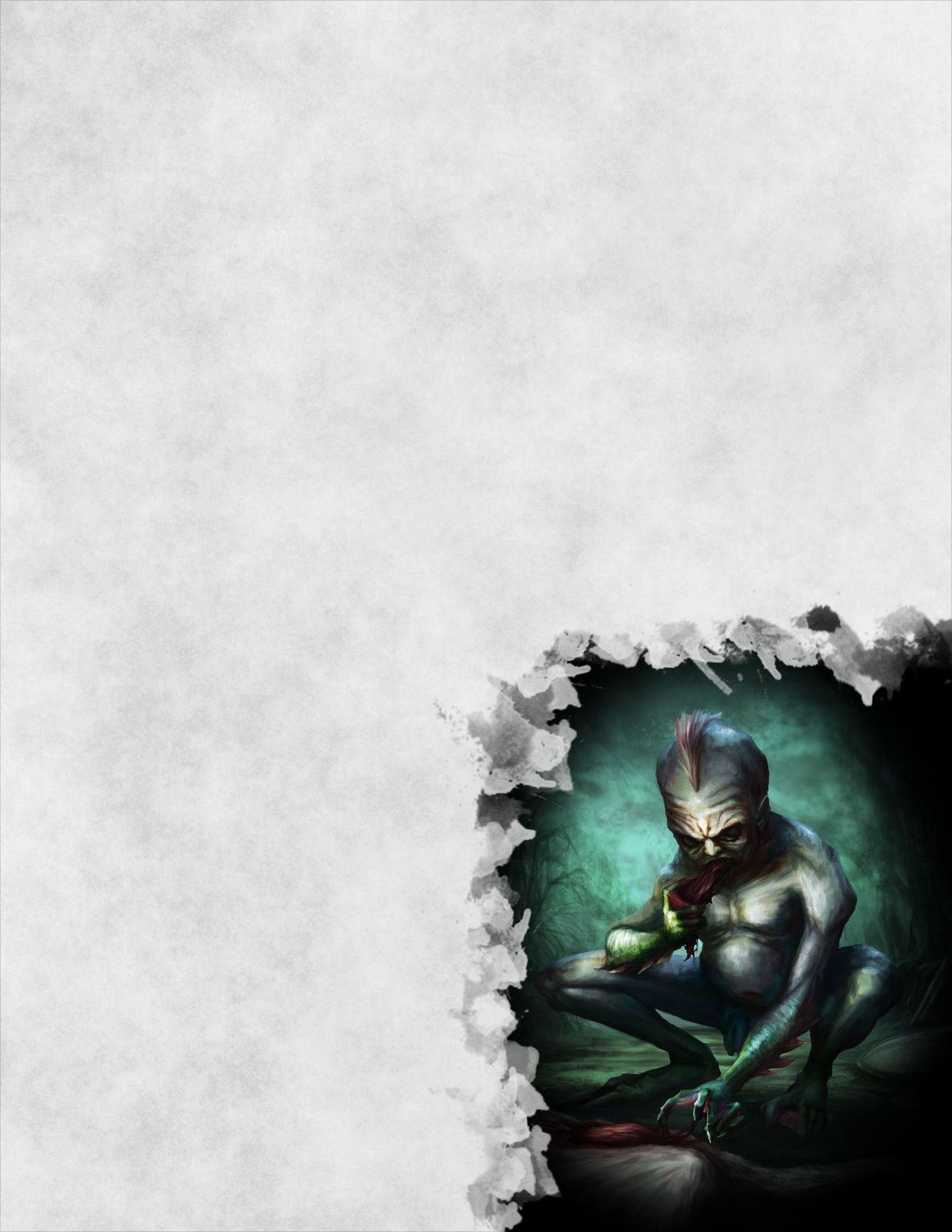
Bog Mummy
Unwitting, inexperienced travelers may easily fall victim to bogs and marshes. Those that do are embalmed in its acidic waters, and hidden from sight by tall grasses. If untouched long enough, it will rise, becoming a bog mummy. They rarely walk too far before falling victim again to hags and crones, only to be used for concoctions or stew.
Bog Mummy
Medium undead, chaotic evil
- Armor Class 13
- Hit Points 66 (12d8+12)
- Speed 20 ft
STR DEX CON INT WIS CHA 16 (+3) 8 (-1) 13 (+1) 6 (-2) 10 (+0) 8 (-1)
- Damage vulnerabilities fire
- damage Resistances acid
- Damage Immunities poison
- Condition Immunities charmed, exhaustion, poisoned
- Senses darkvision 60 ft., passive Perception 10
- Languages thoes known in life
- Challenge 2
Actions
Multiattack. The bog mummy can make 2 attacks with its mucky fist
Mucky Fist. Melee Weapon Attack: +3 to hit, reach 5 ft., one creature. Hit: 7 (1d6+3) bludgeoning damage plus 4 (1d6) acid damage. On hit, the target must succeed on a DC 12 Constitution saving throw or be inflicted with bog fever. The diseased target has disadvantage on Constitution saving throws and is vulnerable to acid damage.
Drowned Dead
A drowned dead may have once been a pirate or convict sent to walk the plank. They are more like ghouls than zombies, and are known to take a bite out of those who wander along eerie waters. Being able to drive away sailors and fishermen, they play an vital part in protecting the aquatic ecosystem.
Drowned Dead
Medium undead, chaotic evil
- Armor Class 13
- Hit Points 44 (8d8+8)
- Speed 30 ft., swim 40 ft.
STR DEX CON INT WIS CHA 13 (+1) 14 (+2) 12 (+1) 7 (-2) 10 (+0) 6 (-2)
- Damage Immunities poison
- Condition Immunities exhaustion, poisoned
- Senses darkvision 60 ft., passive Perception 10
- Languages those known in life
- Challenge 1
Nautilus Grip. The drowned dead has advantage on grappling if the target is underwater and does not have a swim speed. Its bite attack has advantage on targets grappled in this way.
Actions
Bite. Melee Weapon Attack: +2 to hit, reach 5 ft., one creature. Hit: 9 (2d6 + 2) piercing damage.
Claws. Melee Weapon Attack: +4 to hit, reach 5 ft., one target. Hit: 6 (1d6 + 2) slashing damage.
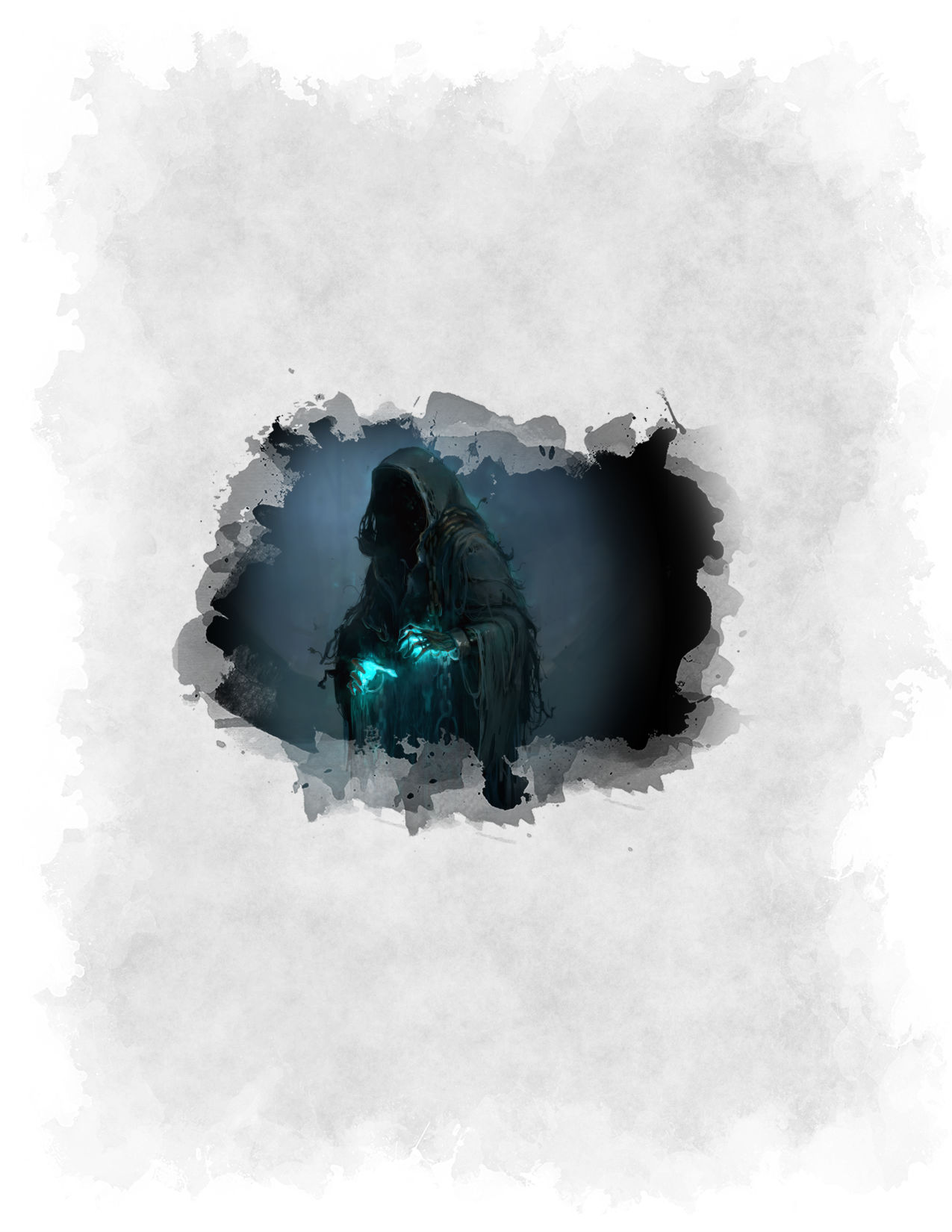
Ice Specter
This variant of specter flies a little slower and glows a mild blue and are often confused for the spirit of Christmas Future.
Ice Specter
Medium undead, chaotic evil
- Armor Class 13
- Hit Points 44 (8d8+8)
- Speed 0 ft., fly 40 ft. (hover)
STR DEX CON INT WIS CHA 1 (-5) 13 (+1) 16 (+3) 10 (+0) 10 (+0) 16 (+3)
- Damage Resistances acid, cold, fire, lightning, thunder; bludgeoning, piercing, and slashing from nonmagical attacks
- Damage Immunities necrotic, poison
- Condition Immunities charmed, exhaustion, grappled, paralyzed, petrified, poisoned, prone, restrained, unconscious
- Senses darkvision 60 ft., passive Perception 10
- Languages understands those known in life
- Challenge 4
Frigid Aura. The specter projects a freezing aura with a 10-foot radius. Creatures without immunity or resistance to cold damage treat the space within the aura as difficult terrain.
When the specter receives radiant damage, the aura is disabled until the end of the specter's next turn.
Incorporeal Movement. The specter can move through other creatures and objects as if they were difficult terrain. It takes 5 (1d10) force damage if it ends its turn inside an object.
Sunlight Sensitivity. While in sunlight, the specter has disadvantage on attack rolls, as well as on Wisdom (Perception) checks that rely on sight.
Actions
Life Drain. Melee Spell Attack: +5 to hit, reach 5 ft., one creature. Hit: 10 (3d6) necrotic damage. The target must succeed on a DC 13 Constitution saving throw or its hit point maximum is reduced by an amount equal to the damage taken. This reduction lasts until the creature finishes a long rest. The target dies if this effect reduces its hit point maximum to 0.
Frigid Howl (Recharge 5-6). The specter unleashes freezing wind in a 20-foot cone originating from itself. Each creature in the area must make a DC 13 Constitution saving throw, taking 14 (4d6) cold damage on a failed save and half damage on a successful one.
Pustular Ghoul
This type of ghoul can be distinguished by its bulbous tumors, which are filled with caustic juices, as a result of mutating. Given enough damage, the fluids will start a chemical reaction that won't end well for the ghoul.
Pustular Ghoul
Medium undead, chaotic evil
- Armor Class 13
- Hit Points 52 (8d8+16)
- Speed 30 ft.
STR DEX CON INT WIS CHA 15 (+2) 14 (+2) 14 (+2) 7 (-2) 10 (+0) 6 (-2)
- Damage Immunities poison
- Condition Immunities charmed, exhaustion, poisoned
- Senses darkvision 60 ft., passive Perception 10
- Languages understands those known in life, but can't speak
- Challenge 3
Volatile. When the ghoul is reduced to half its hit points or fewer, it starts to convulse, becoming incapacitated. At the start of the convulsing ghoul's next turn, it erupts. Each creature within 10 feet of the ghoul must make a DC 13 Dexterity saving throw, taking 10 (3d6) acid damage on a failed saving throw, or half as much on a successful one.
Other pustular ghouls that receive damage of this will also convulse and will erupt at the start of their turns, regardless of their current hit points.
Actions
Multiattack. The ghoul makes two attacks, one with its bite and one with its claws.
Bite. Melee Weapon Attack: +2 to hit, reach 5 ft., one creature. Hit: 9 (2d6 + 2) piercing damage.
Claws. Melee Weapon Attack: +4 to hit, reach 5 ft., one creature. Hit: 7 (2d4 + 2) slashing damage. If the target is a creature other than an elf or undead, it must succeed on a DC 10 Constitution saving throw or be paralyzed for 1 minute. The target can repeat the saving throw at the end of each of its turns, ending the effect on itself on a success.
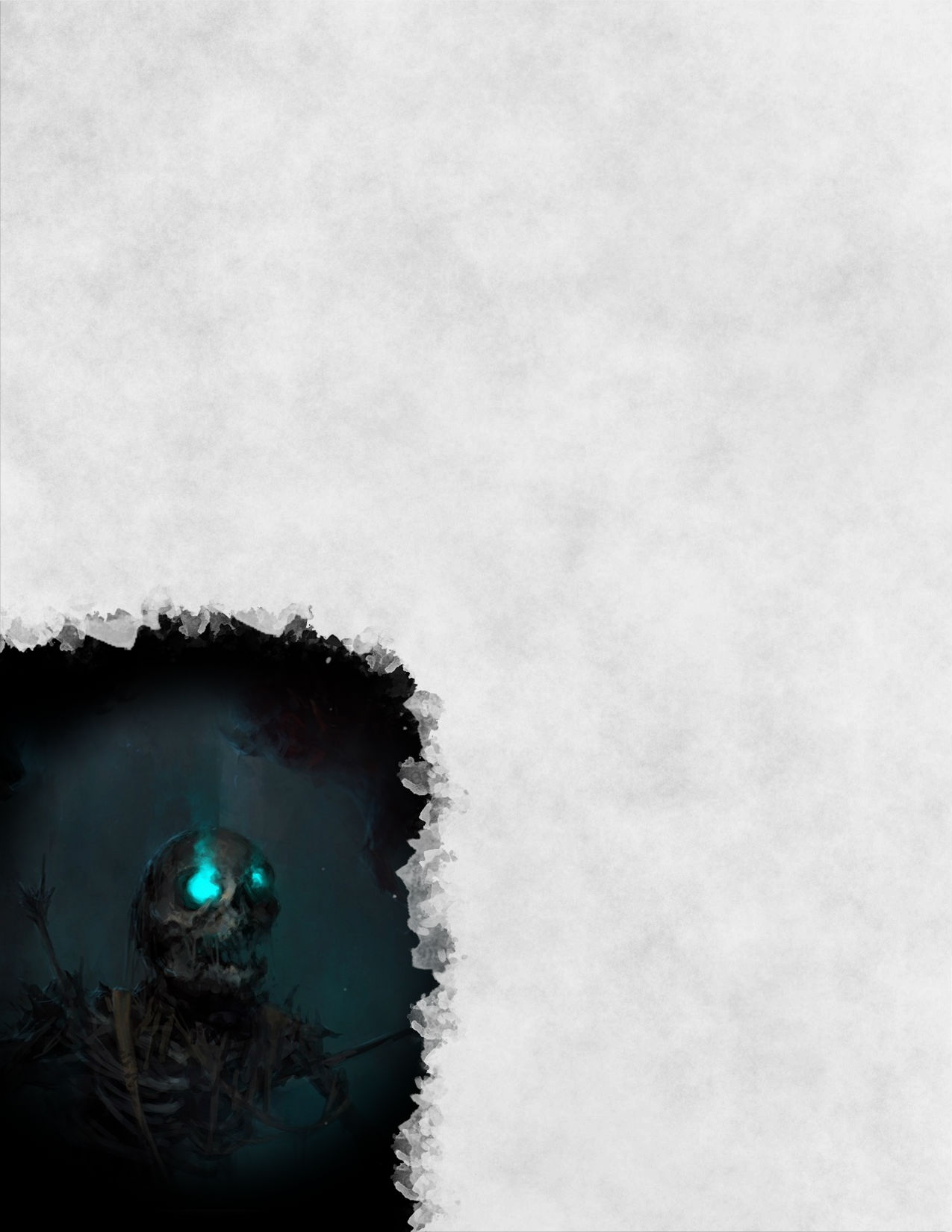
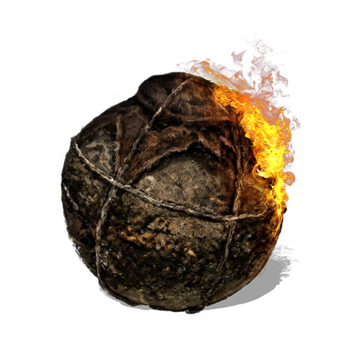
Skeletal Minion
After an animate skeleton has fulfilled its use, a necromancer can still recycle its remains into skeletal minions. The bones of one medium humanoid can yield roughly two to three skeletal minions.
Exploding Skeleton. With a simple ritual, a skeletal minion can be made to carry an explosive bomb. This ritual includes a skeletal minion, an explosive bomb, and the act of giving said explosive bomb to said skeletal minion.
Skeletal Minion
Small undead, neutral evil
- Armor Class 12
- Hit Points 4 (1d6)
- Speed 20 ft
STR DEX CON INT WIS CHA 10 (+1) 14 (+2) 10 (+0) 4 (-3) 8 (-1) 5 (-3)
- Damage vulnerabilities bludgeoning
- Damage Immunities poison
- Condition Immunities exhaustion, poisoned
- Senses darkvision 60 ft., passive Perception 9
- Languages understands the language of its creator but can't speak
- Challenge 0
Actions
Claw. Melee Weapon Attack: +2 to hit, reach 5 ft., one creature. Hit: 3 (1d4) bludgeoning damage
Exploding Skeleton
Small undead, neutral evil
- Armor Class 12
- Hit Points 4 (1d6)
- Speed 20 ft.
STR DEX CON INT WIS CHA 10 (+1) 14 (+2) 10 (0) 4 (-3) 8 (-1) 5 (-3)
- Damage vulnerabilities bludgeoning
- Damage Immunities poison
- Condition Immunities exhaustion, poisoned
- Senses darkvision 60 ft., passive Perception 9
- Languages understands the language of its creator but can't speak
- Challenge 1/8
Explosive Charge. The skeletal minion carries a bomb. Once lit, it will detonate if the skeletal minion dies, if it leaves the skeletal minion's possession, or if the bomb itself is damaged.
When the bomb detonates, all creatures within 10 feet must make a DC 10 Dexterity saving throw or receive 5 (1d8) bludgeoning and 5 (1d8) fire damage. The skeletal minion's body does not provide cover against the detonation, which can be heard 100 feet away
Occupied Hands. This skeletal minion cannot attack.
Outstanding Subtlety. The skeletal minion screams when it uses the Dash Action and can be heard 100 feet away.
Actions
Light Fuse. Rubbing its bones together, the skeletal minion creates sparks that light the bomb's fuse.
PART 3
Rare and Very Rare
Monsters
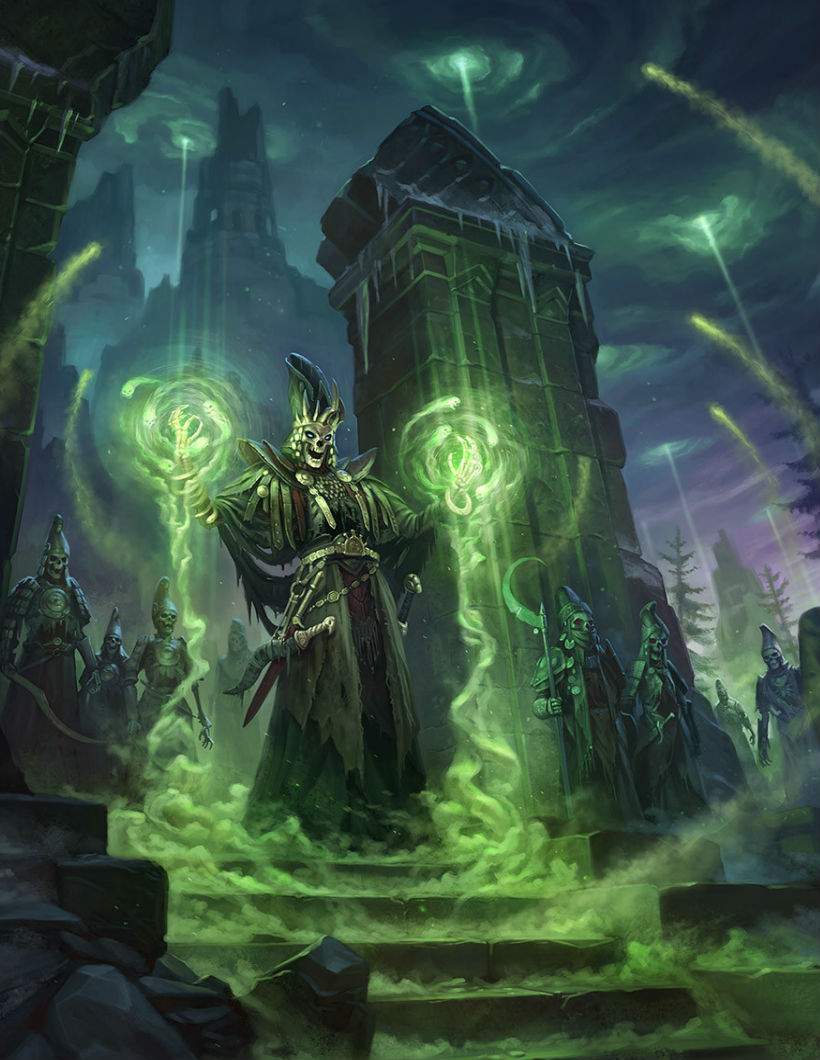
PART 4
Legendary Monsters
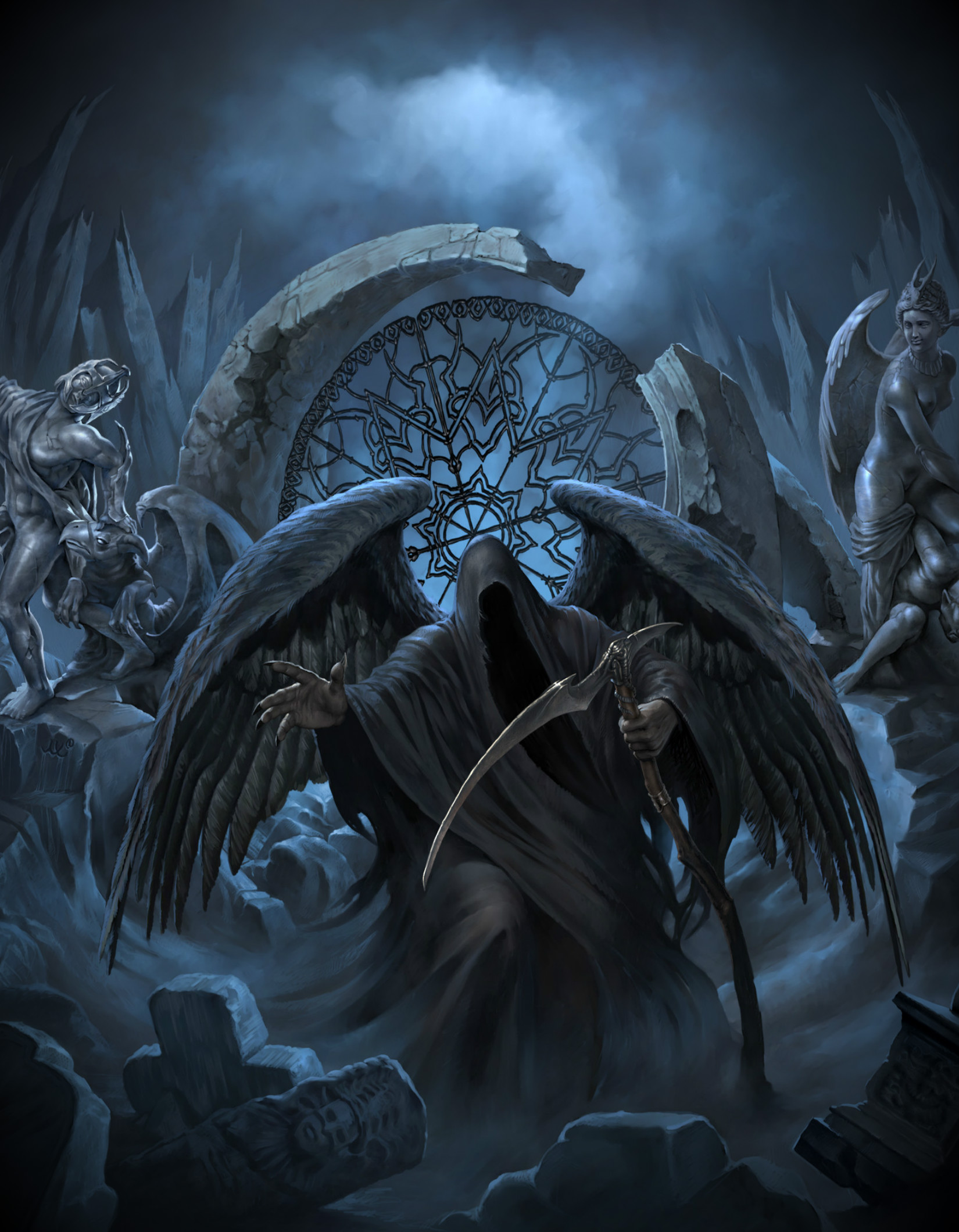
PART 5
Rituals
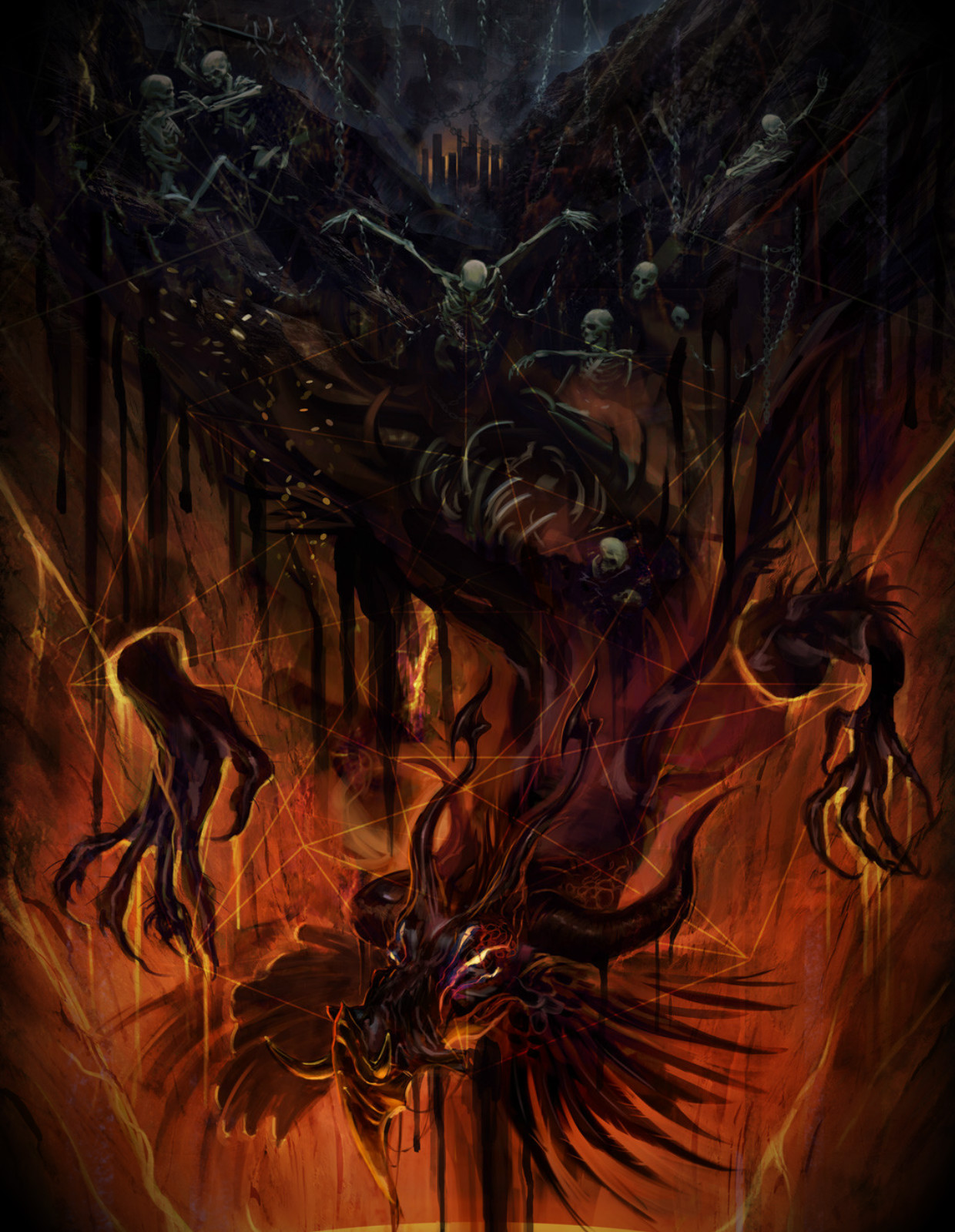
List of Ritual Spells
Cantrips (0 Level)
- Cantrip A
- Cantrip B
- Cantrip C
1st Level
- Spell A
- Spell B
- Spell C
2nd Level
- Spell A
- Spell B
- Spell C
3rd Level
- Spell A
- Spell B
- Spell C
4th Level
- Spell A
- Spell B
- Spell C
5th Level
- Spell A
- Spell B
- Spell C
6th Level
- Spell A
- Spell B
- Spell C
7th Level
- Spell A
- Spell B
- Spell C
8th Level
- Spell A
- Spell B
- Spell C
9th Level
- Spell A
- Spell B
- Spell C
Create Servitor
5th-level necromancy
- Casting Time: 10 minutes (Ritual)
- Range: 15 feet
- Components: V, S, M (300gp of onyx or black pearl, which the servitor will carry)
- Duration: Instantaneous
Target a corpse, pile of bones, or urn of ashes within range that has the mass of approximately one medium humanoid and place the onyx or black pearl within it. After casting, it becomes a servitor under your control. It can be any undead creature of your choice, as long as its size is no larger than medium, its CR is no more than 5, and its species is appropriate to the biotic mass it came from. For example, corpses turn into zombies, ghouls, or wights; bones turn into skeletons; and ashes turn into ghosts, wraiths, or banshees. If its Intelligence score is below 12, it increases to 12.
You can communicate with this servitor telepathically as long as it is in the same realm as you. As a bonus action on each of your turns, you can issue a command telepathically to all servitors created from this spell. You decide what action the servitor will take and where it will move during its next turn, or you can issue a general command, such as to guard a particular chamber or corridor.
The servitor is more intelligent than most other undead. If you issue no formal commands, it will continue to act based on its environment and your behest. It has a will of its own and can find optimal methods and solutions for whatever challenge it faces.
It remains under your control for 24 hours or indefinitely if it stays within an area of unholy power, such as unhallowed ground (level 9). You can reassert or renew your control by casting this spell on the servitor again before those 24 hours expire, without needing any material components. If you lose control of it or it dies, it reverts back into a corpse, pile of bones, or pile of ashes with the onyx or black pearl resting within it (unless emulated via the Consummation invocation).
As an action, you can deactivate the servitor, which will polymorph into the onyx or black pearl used to create it. While in this form, the gem exudes an unholy aura within 10 feet. If the gem is broken or if a creature spends an action to interact with it, the servitor will reactivate, appearing in the nearest unoccupied space.
You can cast this spell using more biotic material to increase its size, 2 additional medium humanoids' worth per increment, to a maximum size of huge. You can also add another 100g worth of onyx or black pearl to increase its CR by 1 to a maximum of CR 10. Whether or not the creature of that size and CR exists or is even available to you is determined by your DM.
Unhallowed Ground
9th-level necromancy
- Casting Time: 12 hours (Ritual)
- Range: Touch
- Components: V, S, M (rare oils, blood, or poisons worth 2000 gp, which the spell consumes)
- Duration: Instantaneous
You touch a point in the ground, infusing it with unholy power. This unholy power becomes an spherical aura with a radius of 60 feet that permeates through the air, floors, and solid walls alike. All areas affected by this aura is considered unhallowed ground. This spell can be cast for longer, increasing its radius by 60 feet every additional 12 hours to a maximum of 360 feet.
Unhallowed ground is permanent and can only be removed with a wish spell. Areas of it can be temporarily neutralized with magic such as hallow or circle of power.
While in unhallowed ground, undead creatures animated by magic will stay animated indefinitely. Corpses not affected by gentle repose (level 2) will have a 20% chance every hour to turn into a zombie.
When you cast a divination spell that targets an area, creature, or object within the unhallowed ground you've created, it automatically succeeds and does not spend any spell slots or require any material components.
PART 6
Spells
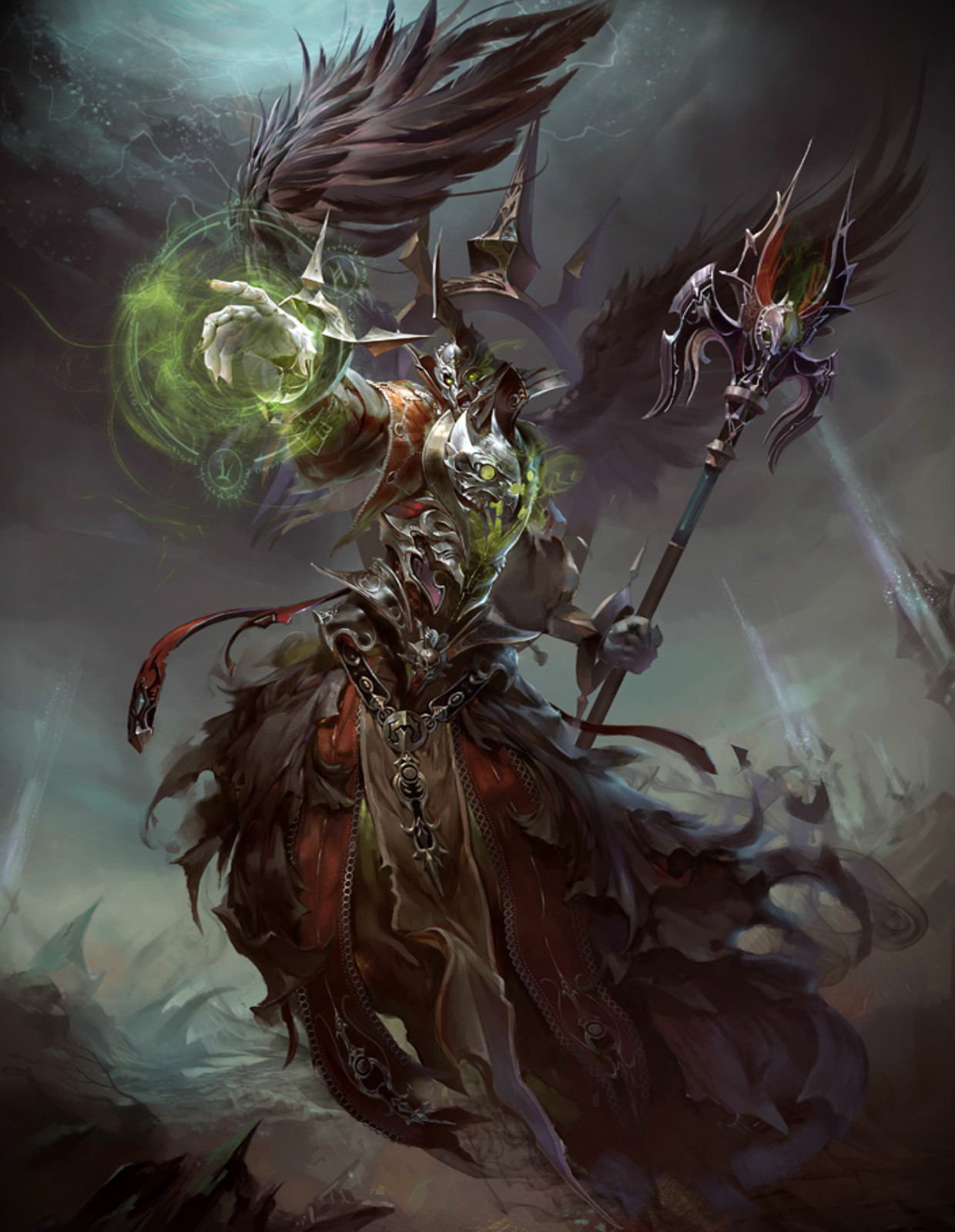
List of Non-Ritual Spells
Cantrips (0 Level)
- Cantrip A
- Cantrip B
- Cantrip C
1st Level
- Curse of Withering
- Spell B
- Spell C
2nd Level
- Conscript Skeletons
- Spell B
- Spell C
3rd Level
- Shadow Word: Sacrifice
- Spell B
- Spell C
4th Level
- Sacrificial Pit
- Spell B
- Spell C
5th Level
- Spell A
- Spell B
- Spell C
6th Level
- Spell A
- Spell B
- Spell C
7th Level
- Spell A
- Spell B
- Spell C
8th Level
- Spell A
- Spell B
- Spell C
9th Level
- Spell A
- Spell B
- Spell C
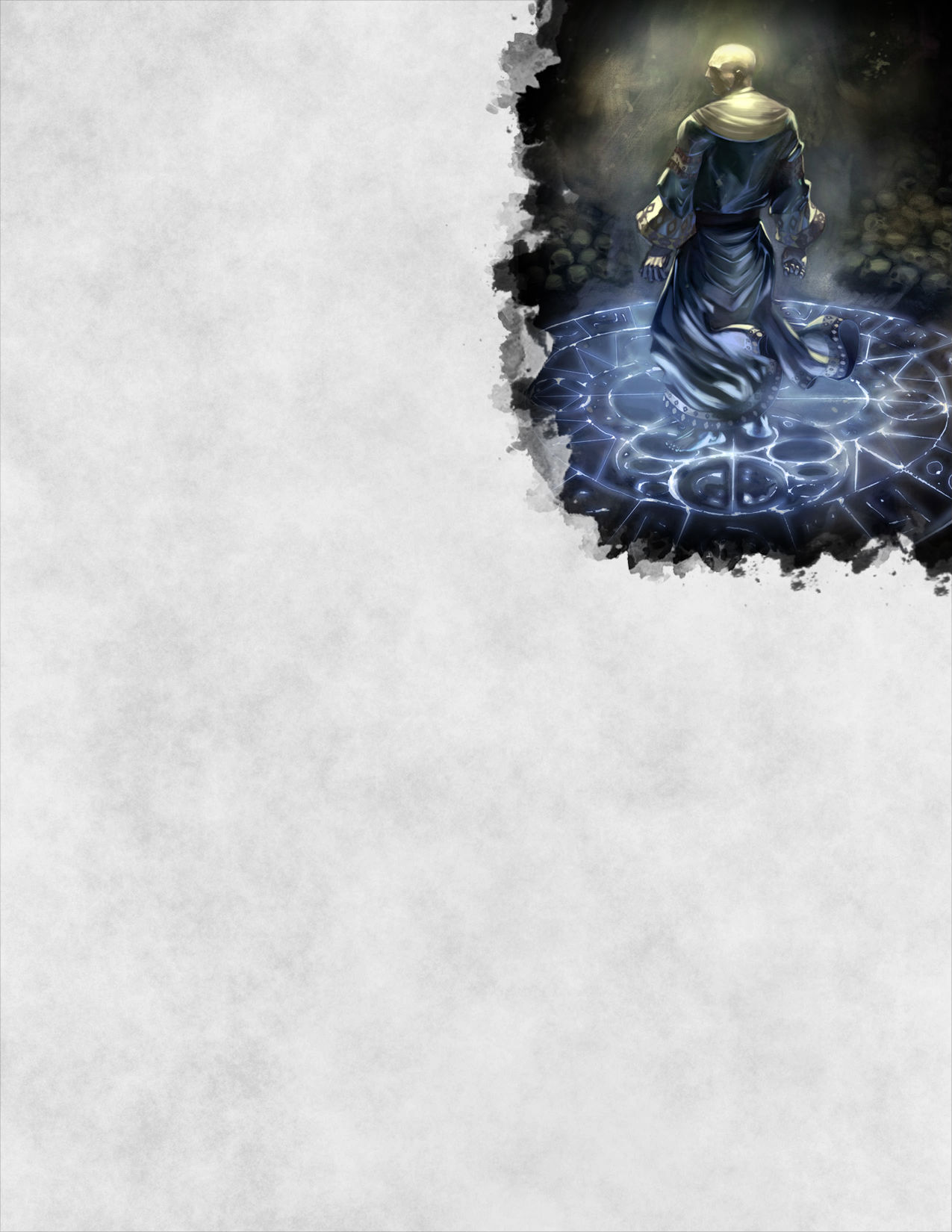
Conscript Skeletons
2nd level necromancy
- Casting Time: 1 action
- Range: Self
- Components: V, S, M
- Duration: 8 hours
When you cast this spell, you animate up to 3 piles of bones within 60 feet into skeletons (1 skeleton per pile). You control them as with the animate dead spell. They remain under your control for 1 minute or until you cast this spell again. Once they die or your control over them is lost, they disintegrate into ash and cannot be used for necromancy again. You can repeat the cast until the end of the duration without having to spend another spell slot.
When you cast this spell using a spell slot of 3rd level or higher, you can animate 1 additional pile of bones for each spell slot level above the 2nd.
Sacrificial Pit
4th-level necromancy
- Casting time: 1 action
- Range: 60 feet
- Components: V, S, M
- Duration: Up to 1 minute (Concentration)
You create an illuminated ritual circle with a 10-foot radius on the ground centered on a point within range. Upon cast, target up to 3 willing non-construct creatures within the ritual circle and have them be sacrificed, killing them instantly. Each creature you choose within 20 feet of the perimeter of the ritual circle must succeed a Constitution saving throw or receive 2d6 Necrotic damage for each creature sacrificed. Those that succeed receive half damage. Diseased creatures have disadvantage on the saving throw
On each of your following turns, you may use a bonus action to again sacrifice 1 willing non-construct creature within the ritual circle, having other creatures within 20 feet of the ritual circle repeat the saving throw. Each time a creature fails its saving throw against this spell, you gain 1 hit-die.
If you are ever out of range of the ritual circle's center, the spell ends. You can also end this spell with a bonus action.
When you cast this spell using a spell slot of 5th level or higher, you can sacrifice 1 additional non-construct creature for each spell slot level above the 4th in the initial and subsequent casts.
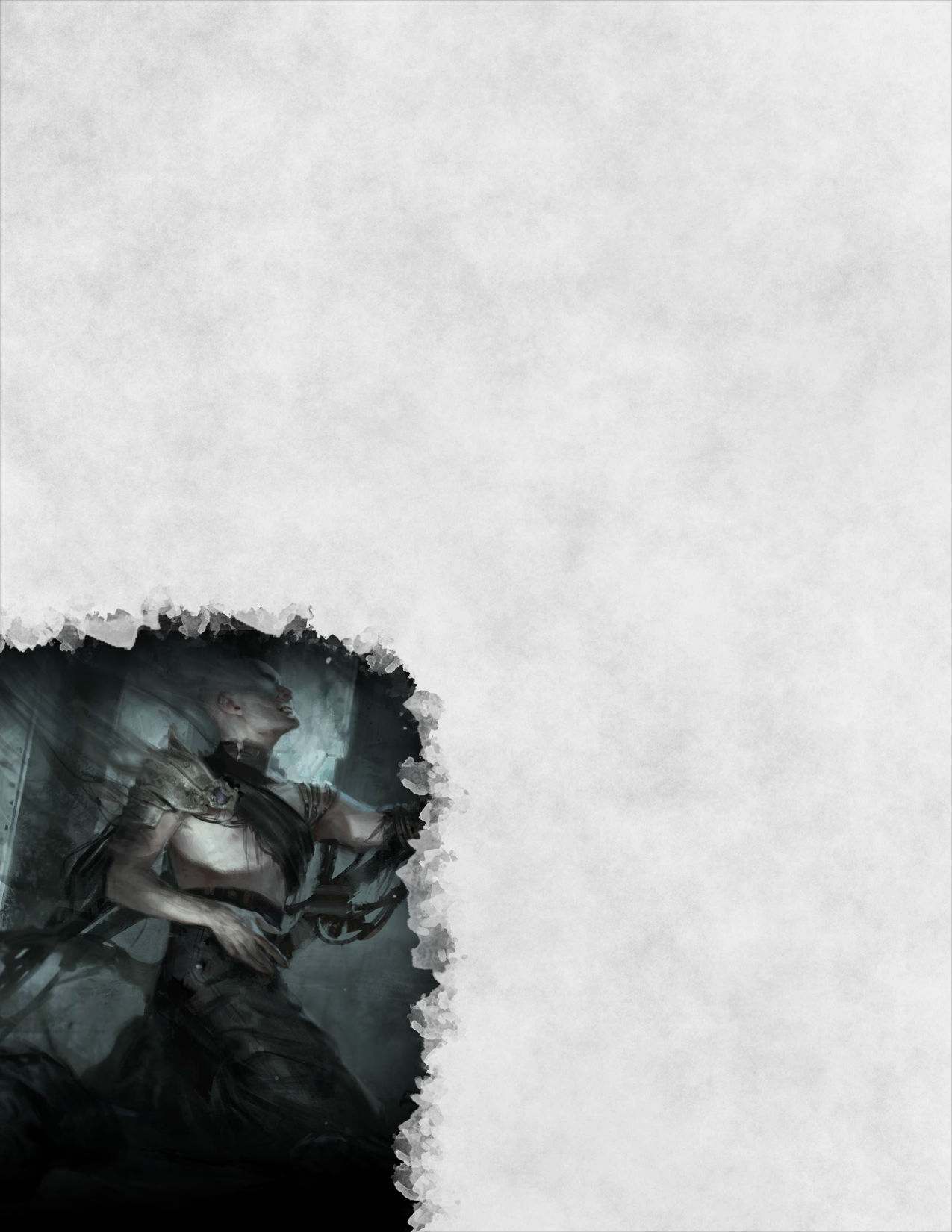
Curse of Withering
1st-level necromancy
- Casting time: 1 action
- Range: 60 feet
- Components: V, S, M
- Duration: Instantaneous
You target a creature and bestow upon it a curse. It must succeed a Charisma saving throw or it becomes cursed, receiving 2d8 Necrotic damage and its maximum health is reduced by the amount of damage taken. On a success, it receives half damage without becoming cursed.
A cursed target cannot benefit from a short or long rest. When the cursed target is reduced to 0 hit points or fewer without dying, it does not fall unconscious, but it still must make death saving throws until stabilized. If it dies by exhaustion or its hit points remain below 1 for 2d4 consecutive hours, it becomes a Witherling. If this occurs within 120 feet of you, you control it as if by the animate dead spell.
When you cast this with a 2nd level spell slot or higher, the initial damage is increased by 1d8 for each spell slot level above the 1st.
Witherlings
A witherling is like a zombie, but very thin and dry. They are the result of when humanoids die without actually dying. This can occur when the victim dies a non-violent, but horrific death, such as being lost to wander, starved to death, or marooned.
Shadow Word: Sacrifice
3rd-level necromancy
- Casting time: 1 action
- Range: 120 feet
- Components: V, S, M
- Duration: Up to 1 minute
You target a creature you can see that is neither undead nor construct. If the target is willing or unconscious, it immediately dies. Their body along with everything carried and worn is disassembled, and their soul lingers in the space where their body once was.
The soul has the same amount of hit points it had before they died, along with all of their stats and features. As a soul, the target is considered undead and has a movement speed of 20 feet, which cannot be reduced. They are immune to all damage except force damage, and receiving necrotic damage restores hit points instead. Furthermore, they are immune to being charmed, exhausted, grappled, paralyzed, petrified, poisoned, prone, restrained, and unconscious.
However, the target cannot perform any actions except moving. They can move through other creatures and objects as if they were difficult terrain. The target takes 5 (1d10) force damage if it ends its turn inside an object.
At any point as a lingering soul, the target can end the spell as a bonus action. When the spell ends, the target's body and belongings are reassembled in the space the soul occupied to full functionality, without being prone or unconscious. The target assumes the hit points they last had as a soul.
If the target has less than 1 hit-point when the spell ends, they are dying and must make death saving throws as normal.
This spell neutralizes any poison and cures nonmagical diseases that affected the creature at the time it died. This spell doesn’t, however, remove magical diseases, curses, or similar effects; if these aren’t first removed from the target's soul prior to ending the spell.